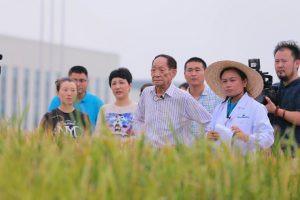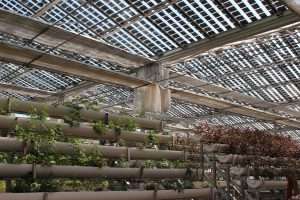Scientist Yuan Longping is taking rice to new places. Together with his team of researchers at the Qingdao Seawater Rice Research Centre, they have developed a new variety of “seawater” rice that is being trialled with promising results.
Unusually among scientists, Yuan is already a household name in China after rising to prominence in the 1970s for developing high-yield, hybrid rice varieties, which now produce 60% of the country’s rice crop.
Based in Qingdao on China’s north-east coast, his latest project is equally ambitious: creating a variety of rice that can be irrigated with saline-alkali water, known in the trade as “saline-alkali tolerant rice”.
The pay-off could be enormous. Not only could China improve its resilience to climate change, seawater rice could help bring 300 million mu (200,000 square kilometres) of land with salty, alkaline soil into production, according to Chinese media site Xinhua. Even cultivating an additional 100 million mu (670 square kilometres) of formerly unproductive land with seawater rice could provide an extra 30 billion kilogrammes of rice a year – enough to feed 80 million people.
Food security
Although China’s food security isn’t under threat, the issue is a sensitive one. In 2013, 13% of grain was imported, according to Qian Keming, chief economist of China’s Ministry of Agriculture. This is expected to rise to 15% in 2020.
But the growth in food imports also comes at a time when interest in new higher-yield rice varieties is falling off, said Zhang Zhaoxin, a researcher with the Ministry of Agriculture’s Rural Academy Institute. On average, China produces about 400 kilogrammes per mu, which is 100 kg more than the global average but less than in the United States, which produces between 538-568 kg per mu.
Jiang Gaoming, an expert in eco-agriculture and a researcher at the Chinese Academy of Science’s Institute of Botany, told chinadialogue that sustained rises in China’s grain output have produced a surplus, which means there is less pressure to chase short-term yields.
Instead, the emphasis has shifted from high yields to a more balanced vision of food production focused on food safety. This means dealing with the negative environmental consequences of intensified agriculture too, such as fertiliser overuse, by adopting more sustainable practices.
Climate resilience
In controlled trials, Yuan’s seawater rice actually performs very well, producing yields of 438-621 kg per mu during last year’s autumn harvest. But the long-term strategic significance of seawater rice may not be its total yield but its adaptability to climate change.
Xie Zhenhua, China’s special envoy on climate change, has argued that international talks on the issue are too focused on trying to mitigate climate change than adapt to it. Trying to prevent climate change from happening is a huge long-term task, but adaptation is equally pressing, particularly for developing nations that face climate change impacts now.
China’s border is 40% coastline so making staple crops more tolerant of salty water will be of major benefit in areas exposed to an increased risk from coastal flooding caused by climate change.
Salty and alkaline land has long been off-limits for crops because the salt in the water dehydrates them, slowing photosynthesis and respiration. Seawater rice could make land that is currently useless productive, or maintain the viability of farmland that’s at risk.
But the development of rice that can thrive in saltwater is still some way off. The water used to irrigate Yuan’s seawater rice trials had salt content of 0.6%. On average, the salinity of seawater is between 2-3.5% in coastal waters.
Xing Junwu, senior engineer with the Chinese Academy of Sciences Institute of Oceanology, wrote in China Science Daily that “seawater rice” is still far from being able to tolerate actual seawater, and that the name is misleading.
Murky commercial outlook
There are other barriers standing in the way of commercialisation. Zhang Shuchen, an employee with an agricultural firm, told Red Star News in Chengdu that it’s difficult to apply results from controlled trials to large-scale planting. And because the rice is only partially resistant to saltwater, it will need freshwater to dilute it which will have to be moved from elsewhere.
Seeds will also be more expensive than other varieties, which could limit commercial uptake, according to Zhang Zhaoxin. However, costs are expected to fall over time as more farmers experiment with salty and alkaline land, which is cheaper to lease than normal productive farmland. If you factor in the cheaper land then overall costs could be much reduced.
In the meantime, rice from Yuan’s most recent trial batch is selling well at 54 yuan a kg (US$8) – eight times the cost of normal rice. Sales staff told Hong Kong newspaper South China Morning Post that there had been almost 1000 orders for seawater rice on the online retail platform Tmall.com. They hope to sell rice worth 10 million yuan (US$1.5 million) in 2017.








